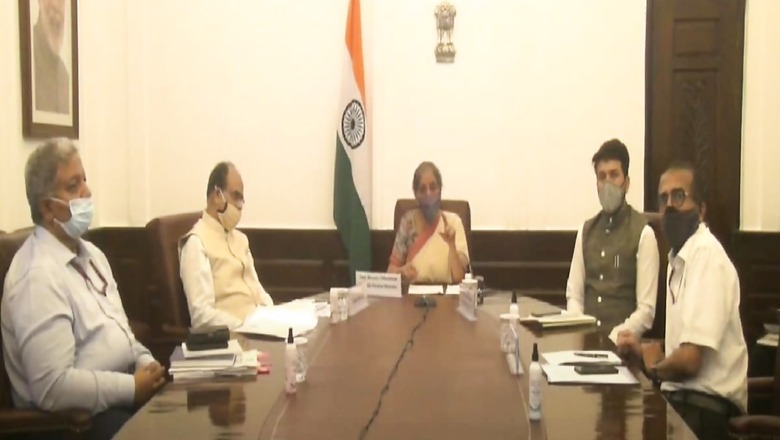
views
The government has chosen the middle path in suggesting a way out of the coronavirus-induced difficulties for state governments due to their own dwindling revenue collections and the expected share of GST compensation from the Centre.
As it is, the Central government has been pushed between a rock and a hard place on overall GST collections since April, which are expected to fall short by Rs 2.35 lakh crore. So in a crucial GST Council meeting on Thursday, the Centre put two options on the table for state governments — 1) for the amount of shortfall expected in the normal course of business, presuming there had been no COVID-19 pandemic and 2) another for the additional amount by which compensation to states would fall short this fiscal due to the pandemic.
In the first instance, the Centre has assured states they would not have to bear any additional liability but in the latter case, it is not clear who will ultimately bear the burden of additional borrowings to finance the shortfall. When myriad Central and state-level taxes were amalgamated into a single tax, the Goods and Services Tax (GST), the Centre had promised the states to compensate for any loss in revenue due to the implementation of GST. The base year taken was 2016-17 and it was agreed that if any state reported revenue growth lower than 14% year on year for the next five years, it would be compensated with the differential amount by the Centre.
In 2017, a cess had additionally been imposed on certain items to compensate state governments for any revenue loss. In any case, the compensation payable to a state was to be provisionally calculated and released at the end of every two-month period. It was subsequently to be finally calculated for every financial year after the receipt of final revenue figures for five years. So the nub of the current problem lies in the Centre being unable to compensate states according to this formula since the beginning of this fiscal. Two instalments of the compensation are due (April-May and June-July) as on date.
What the Centre has now proposed is this: 1) states can approach the RBI to borrow for the compensation gap of Rs 97,000 crore expected this year assuming no outbreak of pandemic. This borrowing can be re-paid by the Centre from the compensation cess fund at a later date. The states will therefore not have any additional liability after borrowing this amount, 2) States can borrow the remaining Rs 1.37 lakh crore, which would be the additional funding gap due to virus-induced fall in cess collection, from the market through government bonds but here, there is no clarity on how this amount will be repaid.
While state governments have been given a week to revert with their replies to these two options, the larger fallout is clear: a) there could either be an increase in the period of cess collection beyond the earlier deadline of 2022, b) there could be an increase in the rate of cess, c) there could be an increase in the items which merit this cess.
Any or all of these options may be discussed at the next GST Council meeting but the upshot is that prices of some commonly used items such as soft drinks, luxury cars, etc are unlikely to be eased in the near future. According to the GST contours, cess collection was to be have ceased by 2022, but Thursday’s deliberations open up the possibility of cess being extended beyond the initial period of five years. If this were to happen, businesses as well as consumers will be hurt. The same fallout can be expected if the council later decides to either raise the cess amount on existing items or include more items under cess. As of now, cess is collected on four categories of products: coal, aerated drinks, tobacco and automobiles.
Sachin Menon, partner and head (indirect tax) at KPMG, said, “The offer of paying the RBI from the cess compensation fund at a later date means the period of collection of cess will have to be extended beyond five years envisaged in the GST Act. This means the Act will have to be amended”.
Thursday’s meeting came in the backdrop of several states, especially those which have non-BJP governments, calling for complete compensation from the Centre. Punjab’s Finance Minister Manpreet Singh Badal has said the Centre owes his state Rs 4,400 crore in GST compensation dues since April. He said the salary bill of the state is Rs 1800 crore and it “is getting difficult for us to run the state”
The State Bank of India noted earlier this month that the decline in states’ own tax revenue due to the pandemic could be nearly Rs 3 lakh crore and another Rs 1.5 lakh crore could be the “revenue loss from the Centre”. Taking into account the additional expenditure of Rs 1.7 lakh crore by states, the total loss comes to around Rs 6.2 lakh crore for major states. This is the amount the states would be set back by through 2020-21.
Some relief measures have already been announced by the Centre during the last few months. For example, it has allowed increased borrowing limit for states, giving extra resources of Rs 4.28 lakh crore. But it cannot be denied that the Centre is also in a tough spot. It recently released GST compensation for FY20 at Rs 1.65 lakh crore, which required it to use the balance of cess amount collected during FY18 and FY19. Hence, it no longer has a cushion to bear the additional burden imposed by the pandemic.
The SBI analysts had suggested that one way out of this conundrum could be “a direct transfer of the combined full amount of Rs 54,000 crore from State Disaster Response Fund (SDRMF) and National Disaster Response Fund (NDRF). An endeavour should be next made to transfer at least 50% of the remaining Rs 2.5 lakh crore through further hike in WMA limits and supporting additional borrowing of states through Open Market Operations by RBI and relaxing some of the conditional ties associated with borrowing. We must appreciate that the states are the most vulnerable as they have limited source of own tax revenue. The fund transfer to states will support also health, immediate payment to contractors for infrastructure work to reduce the stretched working capital cycle which will also have employment and demand boosting properties.”
According to budget estimates, only four out of 20 large states were earlier expected to have their fiscal deficit above the benchmark 3% of their respective state GDP. “However, it seems likely that all states will now register a fiscal deficit much higher than 3% of GSDP as they grapple with lower GSDP growth and reduced taxes,” the SBI analysts have said.



















Comments
0 comment